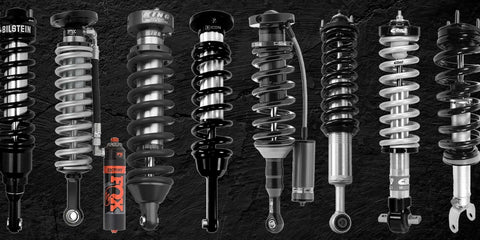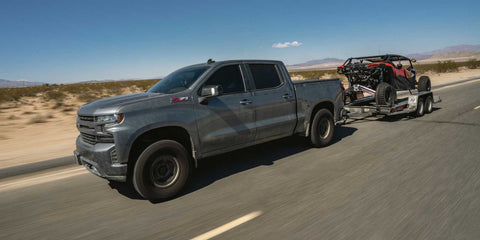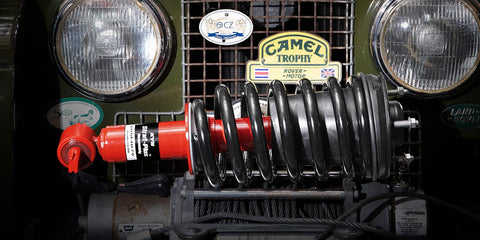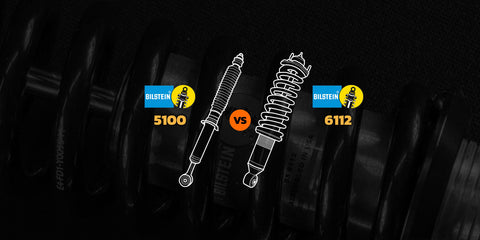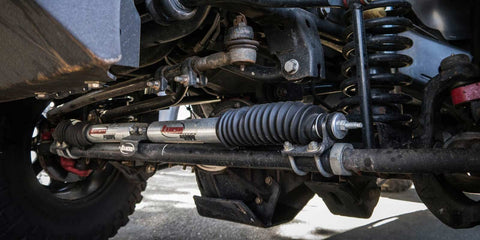Ride Rundown SEMA Edition Part 1 - Baja Rigs
Posted by Brandon Sevestre on
SEMA, Automotive Overload
We undoubtedly fell in love with heaps of builds; however, the further we journeyed through the jam-packed show and the more Sabretts hot dogs we ate, the more we realized that if you didn’t know what to look for, you wouldn’t have half a shot of knowing what you were looking at. We have hopes that this series will help all of you know what to look for, what you may need for your ride, or at the very least open your eyes to what is possible. Maybe you'll be inspired to take a look at modifying what is in your driveway.
Honest Inspiration
Most of our customers come to us knowing precisely what they want to do with their vehicle or what they want to change about the ride or handling. That’s the easy part. Anybody can have a dream or point out a problem, but the solution? Not so simple unless you know where to start. If you have been following along with us here at Shock Surplus, you know we are not scared to tell you the truth about cars, parts, and what is possible rather than gatekeeping readily available knowledge and our wealth of experience. You may be surprised what you can do with your ride, or you might also have to face some harsh realities about your Bilstein 5100s not turning your grocery-getter into a Trophy Truck; however, we hope this series leaves you with a more adept perspective on what’s possible and pertinent with your own build and budget.
Baja Bound
Our primary focus, of course, has always been suspension, and this series is certainly no different. We may or may not have a bit of bias coursing through our veins, but we believe no genre requires more of your suspension than desert racing. Few races, if any, are more grueling than the Baja 1000. Luckily for us, SCORE put together a spectacular display honoring the race cars and prerunners of today and from years past to commemorate the 54th running of this legendary race. Automotive overload meets the precision of aerospace data science, optimizing vehicles with data-driven insights and pushing the automotive industry forward. In this part of the series, we will be taking you through the science, sheer grit, and some of the stories that accompany our favorite cars showcased in this nook of the convention center and hopefully let you see how far the sport and its cars have come.
Ride Rundown - Class 11 Baja Bug
Consisting of mostly stock torsion bar suspension, 1600cc engines with stock carburetors, and enough safety equipment to keep these brave souls alive, these little Beetles are the epitome of doing a lot with a little. Being restrained to such tight class limitations makes suspension tuning and reliability what separates the top cars from the rest. With only a few useable inches of travel through a somewhat archaic suspension design and hardly enough horsepower to get going, these little Baja Bugs rely heavily on being able to be smooth and maintain their speed as it took a while to build up that momentum. Obviously, this takes a surplus of driving skill and an abundance of brave juice; however, you can not keep speeds up through the rough stuff without having your shocks dialed in.
Suspension performance, just like pretty much everything, is determined by quality and quantity. You can have plenty of quantity in travel numbers, however, without a quality damper with the proper tuning to control it, all that travel won’t be doing you any good. Class 11 cars are a great example of not having much travel, but doing wonders with what they have by scraping every bit of performance out of their dampers through maximizing the tune for the application. They can teach us a lot about what is actually important about making something work out in the desert and really show you what things will give you the best performance for your money. Let’s be honest, it is 2021, and few of us will be picking up 50-year-old double-digit horsepower VWs, but this can be very telling on what is worth spending your money on your more modern build.
These rigs are built to be simple, reliable, and as fast as possible given their class limitations, and that should apply to your build as well. Instead of class limitations, your limitations are more likely daily useability and the almighty dollar; however, this ethos will get you quite far on ironing out your ideal build.
Ride Rundown - Resurrected Jeepster
Just one look at this resurrected racer, and we knew it had a great story to tell. The goals of building a production vehicle into a desert racer have always been the same, but the road we take to get there has evolved dramatically over the years. Leaf springs with roller shackles, dual limit straps, more shocks than we can count, and a set of solid axles? This little survivor looks nothing like the race rigs of today, and that's what makes it interesting.
We are not going to lie to you. There is a reason why most top-level SCORE racers do not have solid front axles or leaf springs anymore; however, that certainly does not mean they do not work; they may potentially work very well with the proper setup. I always say leaf springs will get you just as far down the trail as links; you just won’t get there in as much comfort or with as much control. Modern shock technology is doing a lot to make up that gap, so you can get more performance out of your old “poverty springs” even without running three shocks per corner like this old Jeepster. Modern shock absorbers are available in much larger diameter bodies, with position sensitive options like external and internal bypasses, and often feature far more advanced adjustment. Meaning, with a little bit of work and a careful hand to tune, you can turn your old tired leaf sprung rig into something that can kick serious butt at serious speed through the desert or your local trails, all while needing a whole lot fewer shocks than we used to.
Ride Rundown - Big Oly Bronco
Built and piloted by Bill Stroppe and Parnelli Jones respectively, this was one of the first instances of a car going through a complete transformation for the sole purpose of competing and eventually winning the thousand, and indeed the first to be successful. Gone were the solid axle and 4WD of the production Broncos, and in its place was Ford’s ubiquitous twin I beam front suspension used on their 2wd pickups for the next 50+ years. Beams got the name “whoop scissors” for a good reason, and Big Oly was a catalyst without question. The unique yet simple design lends itself to being able to cycle huge travel numbers due to the long arms used and was the basis for many big-name prerunners and race trucks for years.
So how does a multi-million dollar ex-race car in its 6th decade around the sun concern the average enthusiast? 50+ years of beam trucks mean there are plenty of old Ford Rangers and F series trucks out there, and if one is not already in your possession, they can be had for very cheap and built even easier. Radius arms, shock mounts to allow for longer shocks or even a coilover, and some bent or even longer beams, and you can get out there and join party with the best of them.
Ride Rundown- Ivan "Iron Man" Stewart Toyota Tundra Trophy Truck
Although this rugged race rig has worn many shells and different liveries, we got to see it in its final championship-winning Tundra shell. This rig may share a lot in common with the trick trucks of today, however, it is built more like a buggy than the unlimited trophy trucks you will see in this year’s Baja 1000.
This race-winning legend is where things start to stray away from a production vehicle seriously. This truck was a ground-up tube chassis build, and it has taken many years for us to achieve this level of performance in something that can drive on the street. It can be done, but be prepared to start cutting out almost everything and replace it with DOM tubing.
Ride Rundown "Not Your Daddy's Raptor"
Although the silhouettes of both trucks still scream F-150, the only parts left from the Dearborn Plant are between the firewall and back windows of the cab. Everything fore and aft of the cabin, including the frame, has been cut off and replaced with DOM tube or solid chunks of billet. Such extreme measures are necessary to allow for more room for suspension travel, big shocks, big tires, and all the other ingredients needed to rip the roughest courses.
It is no secret that your average bolt-on long travel kit and leaf springs can get you pretty far, however, the factory suspension mounting locations, geometry, and even the frame can limit how much travel the vehicle can cycle without sitting incredibly tall or obscenely wide. With the stock cross member and frame rails out of the way, you can build your own bulkhead and complete front chassis, allowing you to mount much wider upper J and lower A-arms closer together. Control arm length is one of the most significant determining factors in potential travel in your suspension. The wider the arm, the more minor the angle change will be at the arms and their joints, which means you have more range of motion before the suspension binds in either direction. Keen viewers will notice the upper control arm is a J shape instead of the typical A shape, thus the J arm name. This design does have some theoretical benefits for better controlling the caster curve. Still, its primary purpose is to allow for clearance for a pair of large-diameter coilovers and bypasses. These shocks are not just thicker and more plentiful; they are significantly longer than anything that can ever come close to mounting to any factory mount. Thanks to the tube front end, they get mounted to a custom mount built into the tube structure of the front half of the chassis, basically millimeters below the hood line.
There’s no question these shocks have a ton of travel, but they do not cycle 20-28” of travel, so how do these trucks cycle that much travel through the front independent suspension? A little thing called motion ratio. The closer the shocks are to the wheel, the closer that ratio is 1 to 1. Conversely, this ratio increases the closer the shocks mount to the chassis pivot on the lower control arm; however, the more significant the motion ratio, the less dampening force your shocks can produce. In the case of this pair of F-150s, the shocks mount near the middle of the lower front control arm. This means, for every inch of shock travel, the wheels will travel around 2”. You can probably guess that works out to a 2:1 motion ratio, making those massive three or four inch diameter coilovers and bypasses very much necessary.
The chopping does not stop at the front though. The rear frame rails are removed and similarly reimagined with DOM tubing to allow for maximum room for upward travel to compliment the upgrade to a triangulated trailing arm style four-link from the factory leaf springs. Not only are leaf springs more limited in travel than a link set up the shocks mounted to the trailing arms, but the stock frame rails also do not allow for nearly as much up travel without running a huge amount of ride height. This means you can build a rig that not only can swallow the rough stuff, but can keep the center of gravity lower for better handling and control.
No matter what, if starting with a road-going vehicle, you will always have to work around the limitations of how much of the original vehicle you are willing to keep. However, by chopping off the front and back half and building your own, you can get fairly close to trophy truck level performance while still having something you can drive to the shops. I know a lot of you just read all that work you have to do to even come close to having something that can boogie like the big boys and had a heart attack, but that is the big reason why Beams have been a popular choice for front suspension for so long.
A simple bolt-on set of beams, weld in shock hoops, and the right shocks will net you close to the 20+ inches of travel these Geiser-built Prerunners have, albeit with a fairly ugly camber, toe, and caster curve. You still have the same challenges in the rear, but if you can deal with the quirks and compromises of “whoop scissors”, your wallet and welder may appreciate it.
Ride Rundown- Terrible Herbst Racing Unlimited Trophy Truck
Terrible Herbst has been a massive name in desert racing since the early days, and their unlimited class trophy truck definitely shows why. No piece of these trucks was ever designed for regular production cars. This truck was designed from the ground up for the singular purpose of hauling ass through the roughest terrain imaginable for miles on end. One look at this truck and you can see why standard bolt-on parts do not even get you close.
Final Thoughts
These are ground-up builds with one solitary purpose. However, they are a great lesson in what compromises we are willing to make on our own rigs. Each step towards race-level performance moves you away from the comfort and street-ability the original manufacturer of your rig worked so hard to design into it. We all wish our trucks drove like trophy trucks the second we get in the dirt, but none of us will admit we wouldn’t last a minute on our morning commute, eyes burning from race gas and ears bleeding from uniball clatter and bypass clicks. The reality is, race trucks are only good at one thing, so building your truck like one when you get the shaky legs from fire roads may not be the best call.

